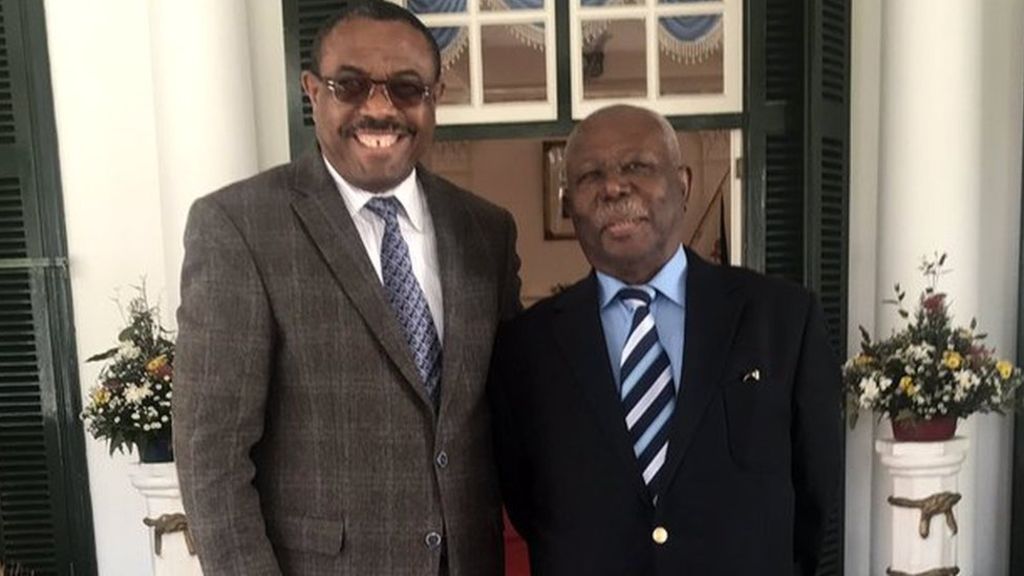Why a photo of Mengistu has proved so controversial
Ethiopia’s former Prime Minister Hailemariam Desalegn has removed a controversial photo he had posted on his Facebook page, which showed him smiling next to the country’s exiled Marxist ex-military ruler, Mengistu Haile Mariam.

But pictures of the meeting, taken in Zimbabwe where Mengistu has lived for nearly three decades, have been widely seen and shared on social media.
Mr Hailemariam is a member of the coalition that overthrew Mengistu – and has been in Zimbabwe this week heading an African Union election observer mission.
He framed his historic meeting as a reconciliation of sorts, as a screenshot of his deleted post shows.
“I wish to see more former heads of government and state in my country contributing their parts in different capacity after peaceful transition of political power,” he wrote in the picture’s caption.
Why is it so contentious?
Mengistu, who oversaw a campaign known as the “Red Terror” in which thousands of people were killed, was found guilty in absentia of genocide in 2007.
Gaim Kibreab, a professor at London’s South Bank University who has written extensively on Mengistu, said the visit was surprising even it was encouraged by Ethiopia’s new reformist prime minister.
Abiy Ahmed, who succeeded Mr Hailemariam in April, has released thousands of political prisoners in his short time of power and made peace with former enemy Eritrea.
“Mengistu is a criminal,” Mr Gaim told BBC Africa online.
A sentiment that has been echoed on social media.
“I wish to see more former heads of government and state in my country contributing their parts in different capacity after peaceful transition of political power,” he wrote in the picture’s caption.
Why is it so contentious?
Mengistu, who oversaw a campaign known as the “Red Terror” in which thousands of people were killed, was found guilty in absentia of genocide in 2007.
Gaim Kibreab, a professor at London’s South Bank University who has written extensively on Mengistu, said the visit was surprising even it was encouraged by Ethiopia’s new reformist prime minister.
Abiy Ahmed, who succeeded Mr Hailemariam in April, has released thousands of political prisoners in his short time of power and made peace with former enemy Eritrea.
“Mengistu is a criminal,” Mr Gaim told BBC Africa online.
A sentiment that has been echoed on social media.
While the response to the photo has been largely critical, it is not to say that public opinion on Mengistu is unanimous, says BBC’s Amharic’s Kalkidan Yibeltal from Ethiopia’s capital, Addis Ababa.
Our reporter says prior to Mr Abiy’s reforms some opposition protesters used Mengistu’s photo – mostly on social media – to express their anger at the government.
Much of that anger has dissipated meaning people are also not afraid to show his image at public gatherings now.
Who is Mengitsu?
In the 1970s, a group of military officers known as the Derg, overthrew Ethiopia’s emperor, Haile Selassie.
Mengistu, a relatively obscure army officer at the time, emerged as leader and began the “Red Terror” when nearly half a million intellectuals, professionals and perceived opponents of socialism or the regime died.
He also declared Ethiopia a Socialist People’s Republic and relied financially on the former Soviet Union during the country’s war with Somalia.
A drought between 1984 and 1985 brought the country to economic ruin – and an estimated one million people starved to death in a subsequent famine.
His regime crumbled in 1991 in the face of the Ethiopian people’s Revolutionary Democratic Front (EPRDF), a coalition of rebel groups, whose fighters had reached the outskirts of Addis Ababa.
His army was also defeated as it fought those struggling for independence in Eritrea, which officially became a country in 1993 – two years after his downfall.
With the help of the US, Mengistu fled to Zimbabwe, where his friend, former President Robert Mugabe, gave him sanctuary.
What’s behind the visit?
No official reason has been given, but there has been plenty of speculation.
Mr Gaim suspects that he was told to visit Mengitsu as the current prime minister’s messenger.
“Without Abiy’s approval he [Hailemariam] would not dare to meet Mengistu,” he said.
Our reporter agrees that many believe it to be part of Mr Abiy’s “forgiveness and reconciliation project”.
Mr Hailemariam stepped down in February after three years of anti-government protests.
His successor has embarked on a series of reforms that would have seemed unthinkable a few years ago.
“I think they [Abiy’s government] are trying to undo what happened in the past, so far what they are doing is quite encouraging and great,” Mr Gaim says.
“I would not surprised if they asked to bring him to Ethiopia.”
But the academic warns that that “would be a travesty of justice”.
“To extend the olive branch to Mengistu is too far and it may antagonise or even disrespect the families who lost their loved ones.” – BBC






